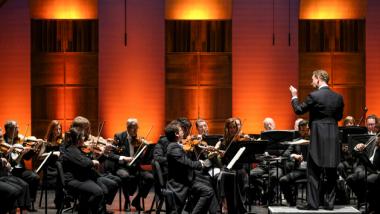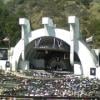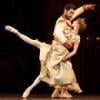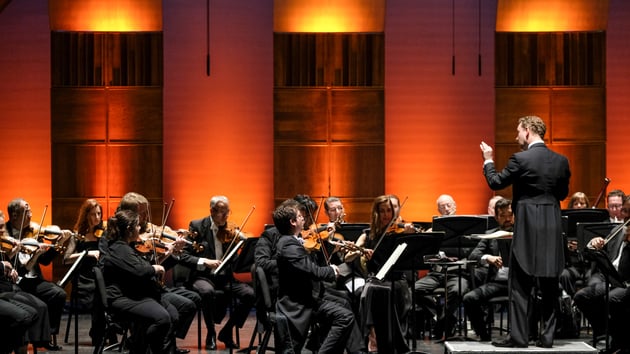
On Saturday, conductor Michael Francis, an amiable soft-spoken Brit and one time double-bass player with the London Symphony Orchestra, led the final performance of this year’s month-long Mainly Mozart Festival.
It’s a musical event, now in its 31st year, that showcases the highest quality musicmaking but seems to fly below the radar of audience awareness beyond the borders of San Diego. On the other hand, the festival is well known and highly regarded among musicians, who consider it a plum assignment.
Now in his fifth season as music director, Francis (who will turn 43 in August) has been navigating a six-season chronological exploration (he prefers the word “journey”) of the significant periods of Mozart’s life. This season showcased his “golden years” in Vienna.
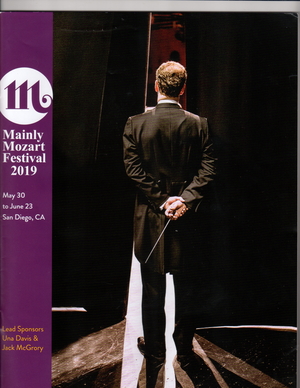
The concert at the Balboa Theater in downtown San Diego (a beautifully restored and acoustically bright former movie palace) began with Mozart’s Symphony No. 38, K. 504 (Prague) with it’s rich, dramatic phrasing and orchestration that would inspire a young Beethoven, followed by the Piano Concerto No. 20, K. 466 with an energized Conrad Tao as soloist, complete with Beethoven’s impassioned cadenzas. It led to the festival’s finale, a performance of Beethoven’s “Pastoral” Symphony, No. 6, Op. 68 that combined birdsong, lyricism, and panoramic grandeur with a torrential downpour and a drunken romp of a peasant party.
Since its founding in 1988, the festival has evolved from a two-week schedule to the entire month of June. And in addition to a full schedule of orchestral and chamber music concerts, the organization explores the scientific/cerebral side of Mozart’s music by hosting a three-day symposium of lectures and concerts called Mozart and the Mind.
But the real aspect that sets the Mainly Mozart Festival apart is its roster of musicians. Like the classical music version of a fantasy draft, the orchestra is made up almost entirely of principal chairs and concertmasters from orchestras throughout the United States and Canada. This idea of assembling an all-star team of musicians was conceived by its founding conductor and music director, David Atherton executive director (and primary fundraiser), Nancy Laturno, and the orchestra’s first concertmaster, William Preucil, then of the Atlanta Symphony.
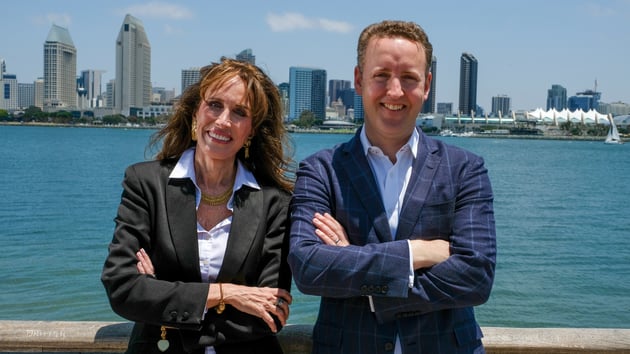
Atherton had been the music director of the San Diego Symphony until 1987, when the organization went into a financial tailspin and cancelled the upcoming season. Atherton, determined to stay in San Diego, was convinced that he could lure the country’s best musicians during the month of June by offering them an idyllic musicmaking setting with Mozart as its center of gravity. The festival he proposed would begin at the end of the major orchestral season and provide a musical oasis before the musicians had to head back home to begin the annual summer pops seasons. The first Mainly Mozart Festival, consisting of nine concerts, took place in 1989. This year’s calendar featured 18 concerts of orchestral, chamber music and celebrity recitals, plus special in-home performances for primary donors.
“For the first three years, we launched the ship and then figured out what we were doing,” Laturno recalls. Led by Atherton, who was highly regarded as a conductor (but far less so for his people skills), along with Preucil as concertmaster and Martin Chalifour (who would later become concertmaster of the Los Angeles Philharmonic), the festival set sail.
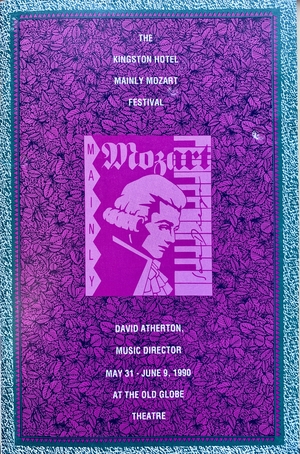
For 31 years the Mainly Mozart Festival has played a significant cultural role in San Diego. But according to a demographic study of its audiences, the festival’s draw barely extends as far north as Orange County. Ironically, it’s much better-known south of the border, because of the long international association the festival has maintained with the five principal municipalities of Baja, Mexico.
In the June 14, 2001 edition of the Los Angeles Times music critic Daniel Cariaga described the Mainly Mozart Festival as “Exciting in every way … an ear-opening delight … immaculate probing Mozart with unexpected, splendid performances.” It was the only time a review of the festival appeared in the Los Angeles Times. So it’s hardly a surprise that this classical music gem has remained San Diego’s best-kept secret.
At the same time, within the interconnected world of musicians, the Mainly Mozart Festival is highly regarded. A young clarinetist I met, Ralph Skiano from the Detroit Symphony, lamented that he had only been hired as a replacement and was afraid he might not be invited back for another season. This was also the first season since the festival’s founding that the concertmaster’s chair was not occupied by Preucil, due to the serious nature of the accusations leveled against him in Cleveland.
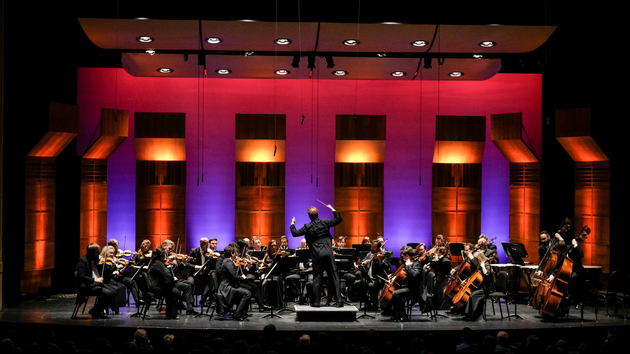
“We miss him very much,” Francis commented to me. “And I think this would have been much more difficult if it had happened in my first year. Bill Preucil set up this great atmosphere with the strings. We’re fortunate that so many of the players were his students and they’ve become capable leaders on their own. What I bring to the organization is a personal sense of collective programming in the form of storytelling as a long-term goal. I want our audiences to see aspects of their own lives reflected in the compositions we play. People that attend our concerts don’t feel intimidated. They feel included. I think that’s one of the reasons our attendance has been growing exponentially.”
That being said, Francis (who is currently music director of the Florida Orchestra in Tampa and was recently appointed chief conductor of the Staatsphilharmonie Rheinland-Pfalz, in Spyer, Germany), admitted he’d never heard of Mainly Mozart until he was contacted as a potential replacement for Atherton, who’d held the post for 25 years. “I thought they meant Mostly Mozart,” he conceded rather sheepishly.
The first Mainly Mozart concert I attended was on Thursday. It was a mixed program under the title Love, Life, Loss: Wagner’s Siegfried Idyll; Rodrigo’s Concierto de Aranjuez (with Pepe Romero as soloist); Ravel’s Mother Goose Suite; concluding with Mozart’s Symphony No. 36, K. 425 (Linz).
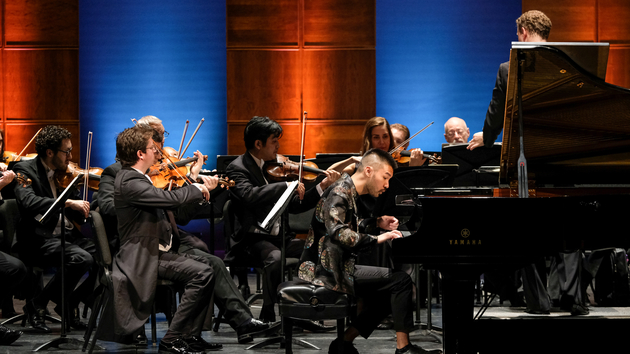
Speaking with casual authority and a jovial sense of camaraderie, Francis drew a through line for his audiences from Wagner’s dulcet birthday present for Cosima, to Rodgrio’s passionate guitar evocation of grief over the loss of his child, to the childlike wonders of the Mother Goose Suite, ending with the symphony Mozart composed only two months after the death of his first child.
I’d been told by friends to expect an all-star ensemble. Even so, I was not prepared for the level I encountered. The strings included (among others) David Radzynski, concertmaster, Israel Philharmonic; Juliana Athayde, concertmaster, Rochester Philharmonic Orchestra; Nicholas Wright, concertmaster, Vancouver Symphony Orchestra; Barry Gold, Los Angeles Philharmonic; Jeffrey Zehngut, Cleveland Orchestra; Remi Pelletier, New York Philharmonic. Among the wind players: Christina Smith, principal flute, Atlanta Symphony; Andrew Bain, principal horn, Los Angeles Philharmonic; Amy Jo Rhine, horn, Los Angeles Philharmonic; Whitney Crockett, principal bassoon, Los Angeles Philharmonic; Nathan Hughes, principal clarinet, Metropolitan Opera; Josh Ranz, principal clarinet and basset horn, Los Angeles Chamber Orchestra, and so on. Then there was the list of festival soloists: Jeremy Denk, Anne-Marie McDermott, Augustine Hadelich, Pepe Romero, and Conrad Tao.
For me it began with the sumptuous rise and fall of tempos and emotional variations Francis and the orchestra brought to the Siegfried Idyll. But it was the Rodrigo concerto and the solo performance by Romero (who had been a long-time friend of Rodrigo and whose family was in the audience, including his son who had crafted the guitar he was playing) that proved the most memorable. It was remarkable. Romero even related to Francis (the conductor told me later) that Romero felt this was one of the most powerful renditions of the concerto he could remember. That’s saying a lot, if you think how often he has played this all-too-familiar work.
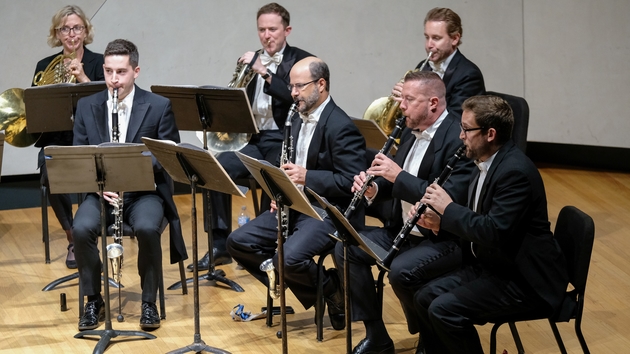
For its chamber music event the following night, the festival moved to the intimate setting of the Scripps Research Auditorium, on the campus of Scripps Institute in La Jolla. The concert featured a long-winded (pun intended), expertly executed complete performance of Mozart’s Serenade No. 10, K. 361, “Gran Partita.”
Saturday, especially for those that had attended the entire festival “journey,” climaxed with the resonant intersectional voices of the “Prague” Symphony, the pyrotechnical virtuosity of Conrad Tao (and the explosive Beethoven cadenzas), and the lush landscapes, and triumphal finale of the “Pastoral.”
From now on, the Mainly Mozart Festival really should be on everyone’s classical music radar. I’m just embarrassed that it took me 31 years to find that out.

